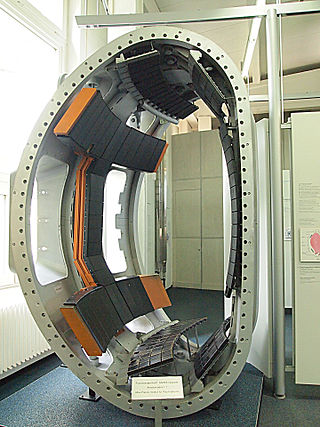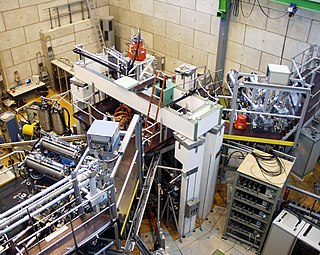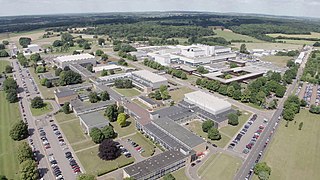
A tokamak is a device which uses a powerful magnetic field generated by external magnets to confine plasma in the shape of an axially-symmetrical torus. The tokamak is one of several types of magnetic confinement devices being developed to produce controlled thermonuclear fusion power. The tokamak concept is currently one of the leading candidates for a practical fusion reactor.

In plasma physics, plasma stability concerns the stability properties of a plasma in equilibrium and its behavior under small perturbations. The stability of the system determines if the perturbations will grow, oscillate, or be damped out. It is an important consideration in topics such as nuclear fusion and astrophysical plasma.

Fusion power is a proposed form of power generation that would generate electricity by using heat from nuclear fusion reactions. In a fusion process, two lighter atomic nuclei combine to form a heavier nucleus, while releasing energy. Devices designed to harness this energy are known as fusion reactors. Research into fusion reactors began in the 1940s, but as of 2024, no device has reached net power, although net positive reactions have been achieved.
This timeline of nuclear fusion is an incomplete chronological summary of significant events in the study and use of nuclear fusion.

Magnetic confinement fusion (MCF) is an approach to generate thermonuclear fusion power that uses magnetic fields to confine fusion fuel in the form of a plasma. Magnetic confinement is one of two major branches of controlled fusion research, along with inertial confinement fusion.

Mega Ampere Spherical Tokamak (MAST) was a nuclear fusion experiment, testing a spherical tokamak nuclear fusion reactor, and commissioned by EURATOM/UKAEA. The original MAST experiment took place at the Culham Centre for Fusion Energy, Oxfordshire, England from December 1999 to September 2013. A successor experiment called MAST Upgrade began operation in 2020.

DEMO, or a demonstration power plant, refers to a proposed class of nuclear fusion experimental reactors that are intended to demonstrate the net production of electric power from nuclear fusion. Most of the ITER partners have plans for their own DEMO-class reactors. With the possible exception of the EU and Japan, there are no plans for international collaboration as there was with ITER.

DIII-D is a tokamak that has been operated since the late 1980s by General Atomics (GA) in San Diego, California, for the United States Department of Energy. The DIII-D National Fusion Facility is part of the ongoing effort to achieve magnetically confined fusion. The mission of the DIII-D Research Program is to establish the scientific basis for the optimization of the tokamak approach to fusion energy production.

The Experimental Advanced Superconducting Tokamak (EAST), internal designation HT-7U, is an experimental superconducting tokamak magnetic fusion energy reactor in Hefei, China. The Hefei Institutes of Physical Science is conducting the experiment for the Chinese Academy of Sciences. It has operated since 2006.

ASDEX Upgrade is a divertor tokamak at the Max-Planck-Institut für Plasmaphysik, Garching that went into operation in 1991. At present, it is Germany's second largest fusion experiment after stellarator Wendelstein 7-X.

The tokamak à configuration variable is an experimental tokamak located at the École Polytechnique Fédérale de Lausanne (EPFL) Swiss Plasma Center (SPC) in Lausanne, Switzerland. As the largest experimental facility of the Swiss Plasma Center, the TCV tokamak explores the physics of magnetic confinement fusion. It distinguishes itself from other tokamaks with its specialized plasma shaping capability, which can produce diverse plasma shapes without requiring hardware modifications.
An edge-localized mode (ELM) is a plasma instability occurring in the edge region of a tokamak plasma due to periodic relaxations of the edge transport barrier in high-confinement mode. Each ELM burst is associated with expulsion of particles and energy from the confined plasma into the scrape-off layer. This phenomenon was first observed in the ASDEX tokamak in 1981. Diamagnetic effects in the model equations expand the size of the parameter space in which solutions of repeated sawteeth can be recovered compared to a resistive MHD model. An ELM can expel up to 20 percent of the reactor's energy.
Derek Charles Robinson FRS was a physicist who worked in the UK fusion power program for most of his professional career. Studying turbulence in the UK's ZETA reactor, he helped develop the reversed field pinch concept, an area of study to this day. He is best known for his role in taking a critical measurement on the T-3 device in the USSR in 1969 that established the tokamak as the primary magnetic fusion energy device to this day. He was also instrumental in the development of the spherical tokamak design though the construction of the START device, and its follow-on, MAST. Robinson was in charge of portions of the UK Atomic Energy Authority's fusion program from 1979 until he took over the entire program in 1996 before his death in 2002.

The Culham Centre for Fusion Energy (CCFE) is the UK's national laboratory for fusion research. It is located at the Culham Science Centre, near Culham, Oxfordshire, and is the site of the Joint European Torus (JET), Mega Ampere Spherical Tokamak (MAST) and the now closed Small Tight Aspect Ratio Tokamak (START).

A ball-pen probe is a modified Langmuir probe used to measure the plasma potential in magnetized plasmas. The ball-pen probe balances the electron and ion saturation currents, so that its floating potential is equal to the plasma potential. Because electrons have a much smaller gyroradius than ions, a moving ceramic shield can be used to screen off an adjustable part of the electron current from the probe collector.

Sir Steven Charles Cowley is a British theoretical physicist and international authority on nuclear fusion and astrophysical plasmas. He has served as director of the United States Department of Energy (DOE) Princeton Plasma Physics Laboratory (PPPL) since 1 July 2018. Previously he served as president of Corpus Christi College, Oxford, since October 2016. and head of the EURATOM / CCFE Fusion Association and chief executive officer of the United Kingdom Atomic Energy Authority (UKAEA).
In plasma physics and magnetic confinement fusion, the high-confinement mode (H-mode) is a phenomenon and operating regime of enhanced confinement in toroidal plasma such as tokamaks. When the applied heating power is raised above some threshold, a toroidal plasma transitions abruptly from the low-confinement mode (L-mode) to the H-mode where the energy confinement time approximately doubles in magnitude.
Hartmut Zohm is a German plasma physicist who is known for his work on the ASDEX Upgrade machine. He received the 2014 John Dawson Award and the 2016 Hannes Alfvén Prize for successfully demonstrating that neoclassical tearing modes in tokamaks can be stabilized by electron cyclotron resonance heating, which is an important design consideration for pushing the performance limit of the ITER.
John 'Jack' Connor is a British theoretical physicist whose research focussed on understanding the physics of nuclear fusion.












